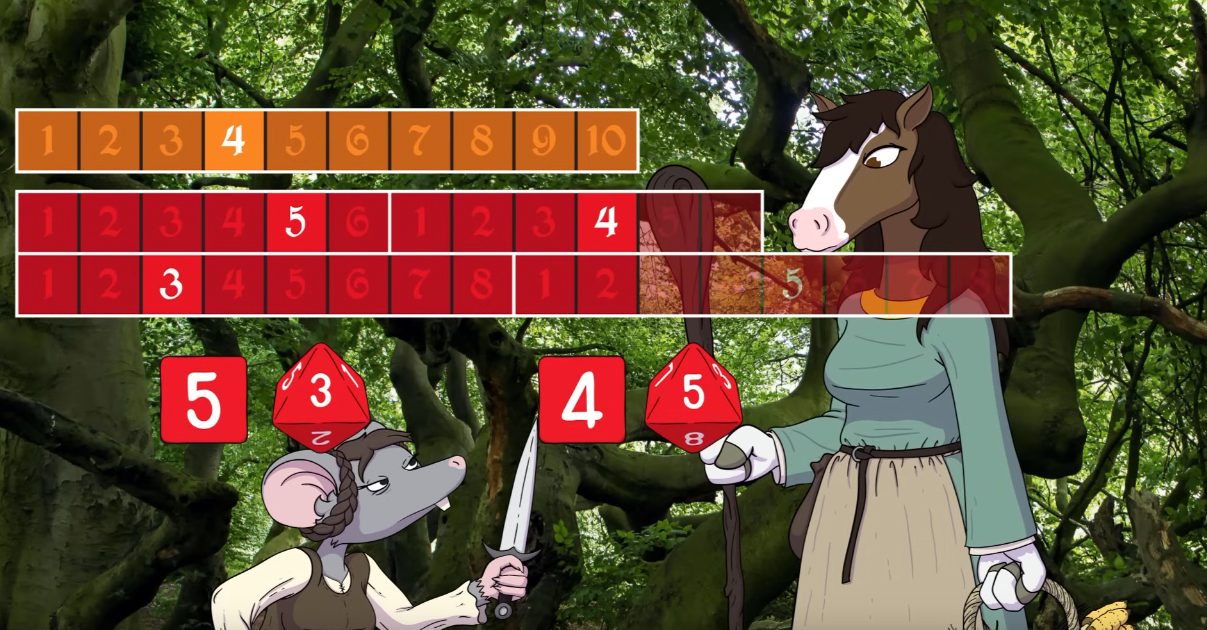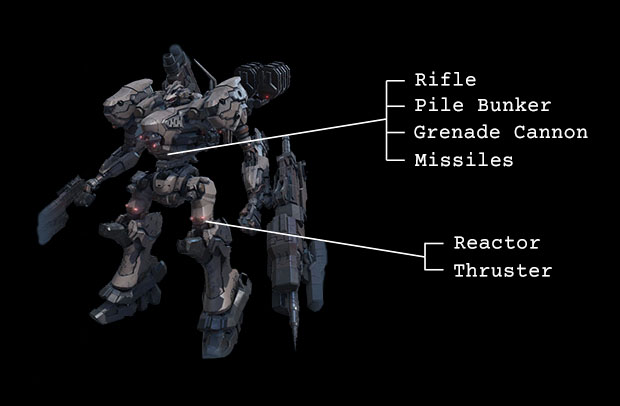Full Metal Bones is the mecha game I’m developing; it’s currently on the back burner as I’ve been working on my other project. That said, the back burner is still cooking and I was reminded earlier this week that I’ve got a terrible idea for initiative after reading through the newly-updated Every Initiative Method masterpost by Dwiz. While we usually think of initiative as a system for determining who goes first, Dwiz uses the term to encompass the entirety of “who does what, when?”. Some games don’t even have turns at all, and others have phases that all players go through simultaneously.
The original seed for the system I’m about to describe sprouted when I watched Zigmenthotep‘s video on Furry Outlaws:
Very specifically I got to the part where they talk about how initiative / combat works in Furry Outlaws:

And I thought to myself: “hey I could make this into a mecha game”. From there, the idea has been in the back of my head for a month as I tried to figure out how I would translate and handle the edge cases. I think I have successfully built a monster.
The Premise
This is a system for high-speed mecha combat. Players do not take individual turns. Gameplay proceeds on a second-by-second basis, and all actions taking place on a specific second resolve simultaneously*. Let’s take our buddy Raven as an example:

Raven has four weapons and a reactor and a thruster. Each minute of combat has 60 seconds, but we’ll divide that into three 20-second beats. During the first beat of combat, Raven fires their rifle on the 4th, 8th, and 18th seconds. Their opponent, Loader 4, fires a machine pistol on the 3rd, 8th, 12th, 13th, and 18th seconds. On the 8th and 18th seconds, both of them are attacking — that’s fine. Damage resolves simultaneously, even if one of them takes the other out, they still receive the incoming damage.
You might be asking, “How do you determine when you can attack?”. Excellent question.

Each weapon is assigned a die size. At the start of each beat, you roll dice until you “fill up” the 20 seconds to determine your ability to get a target lock with a given weapon. Because the rifle uses a d6, it can attack for a minimum of 3 times, with a possible 4th target lock. In this example, we rolled 4d6 and got a 4, 2, 6, and 5. The target lock is acquired on the number rolled, and it lasts until the “end of the die”. So the first target lock happens on the 4th second and it lasts through the 6th second. At the end of the die, the fire control system has to re-acquire the target.
The second rifle target lock is “2”, which means it happens on the 6+2 = 8th second of the beat, and it lasts all the way until the 12th second. Because we rolled a 6 for the third target lock, our FCS doesn’t get the lock until the end of the cycle and it lasts only for a single second: the 18th second. The fourth possible lock was rolled as a 5, but there are only 2 more seconds left in the beat. Thus, we only get 3 possible attacks with the rifle during this beat, and the remaining seconds are chalked up to recalibration, reloading, or cooldown.
Target Locks
Players can attack any time during a target lock, which means they can “hold” their attack until they get in range. They may also choose not to attack despite having a target lock in order to conserve ammo or energy. This game mechanic is an abstraction of high-speed mech combat: sometimes there may not be any valid targets despite “acquiring” a target lock. The same system used to determine “initiative” is also being used to determine if you hit the target. There is no “roll to see if you hit” in Full Metal Bones, only the challenge of getting a target lock and being in range.
The Other Weapons
The pile bunker uses a d12 to attack, which means it gets a minimum of one attack but usually two per beat. In this case, because we rolled a 6 on the second lock, we can attack from 10-12 and 18-20. The grenade cannon has a d20 attack, which means we only ever get one attack per beat, but the wide range means that we can get some really long windows. In this case, our lock lasts from 11-20. Finally, the missiles can attack 2-3 times per beat, and we get locks on 8, 14-16, and then 17-20.
The Reactor
I’ve talked some about my ideas for energy generation in previous posts, but for this example we’re keeping it simple. Raven is piloting a mass production unit which has a “normal” reactor that starts full of energy and generates more energy over time. Their reactor is labelled “10 | 30” which is shorthand for saying it has a capacity of 30 and it restores energy every 10 seconds. The amount of energy isn’t important for our purposes in this post. Players can spend that energy on things like beam rifles, but most importantly energy governs your ability to move.
Thrusters
Movement in Full Metal Bones is beyond the scope of this post, but essentially we do not care where a given combatant is, only their speed and direction. It is assumed that all mechs are flying around the same relative battlefield and it doesn’t take them long to get anywhere in particular. Speed and direction are what we use to determine whether an enemy is in range of your weapons.
On any given second, you can use your thrusters. Activating them costs energy. In Raven’s case, a thruster burn costs 6 energy. Without calculating for reactor generation, this means that they can boost five times based on their initial capacity of 30. You can do three things with a boost:
- Change speed.
Your mech’s thrusters will indicate a maximum speed. - Change direction.
Keep your speed and momentum but change orientation. - Quickboost (“dodge”)
Allows you to avoid attacks. Can also be used to rapidly change direction, but doing so may impact your speed.
Remember way back when I said that “all actions taking place on a specific second resolve simultaneously*“? That asterisk is there for a reason. This is the actual order of operations for actions:
- Reactor generates energy
- Quickboosts happen
- All weapon attacks resolve
- Normal movement
If a weapon attack is declared and targeting you, you may quickboost in response in order to avoid the attack. Some weapons may affect this, such as seeking missiles which require multiple quickboosts in order to fully dodge. Also note that reactor generation happens before anything, which may be immediately used to fuel subsequent actions like boosts and energy weapons.
This initiative system has been the demon living in the back of my head for a month. I’m not sure if it will hold up under actual play, but the thought of it excites me. It feels like it could really drive home the experience of high speed mecha combat. Let me know what you think in the comments!
